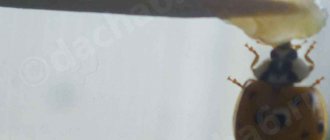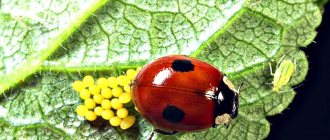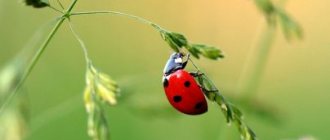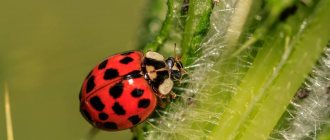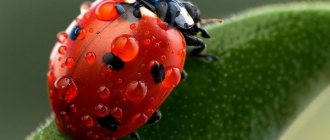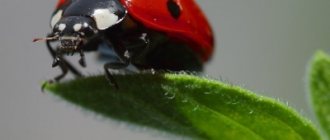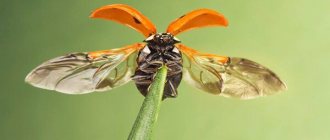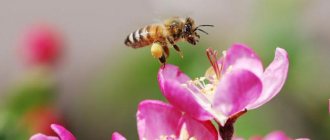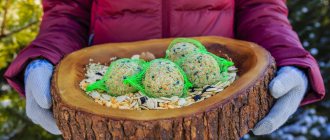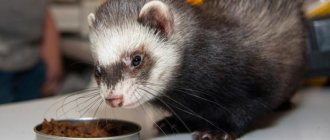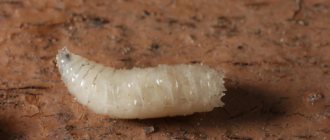What do ladybugs eat? Most are predators and eat other insects, many of which are considered serious plant pests. The ladybug is often called a gardener's best friend. They eat aphids, thereby controlling the number of insect pests in the garden and replacing the use of chemical pesticides. Ladybug larvae also feed on aphids. They also eat other insects that have soft bodies - mites, whiteflies, scale insects and others.
Ladybug: life cycle
There are more than 4,000 species of these interesting representatives of the insect world (Latin name: Coccinellidea) in the world. What do ladybugs eat? Adults and larvae feed on soft-bodied pests, plant mites and egg pests. What they love most is aphids! One individual usually eats more than 5,000 aphids in its life. What is their life cycle? The female lays her eggs (5-20 pieces) on the leaves or stems of plants. After about a week, the eggs hatch into larvae that look like tiny crocodiles. Before becoming a pupa, the larva consumes 350 to 400 aphids.
The larvae go through several stages of maturation. After about a month, the larvae pupate, and a week later young beetles appear. At this stage, they are completely different from the adults that people used to call ladybugs. Their distinctive features are their spots and bright color, which are meant to make them less attractive to any predators.
Description
These beetles from the order Coleoptera are found in almost all climatic zones of the world. There are almost 4,000 species on the planet; 221 species of these insects live in our country alone.
Ladybugs vary in size, body shape, elytra color and number of spots. Thus, shades can vary from yellow and orange to poisonous red. These bright colors provide protection to the insects from birds of prey and other insects.
Contrary to popular belief, the number of dots on the wings does not depend on the age of the beetle, but only on the species.
The lifespan of a ladybug is 1 – 2 years. During this time, the insect goes through 4 stages:
- egg;
- larva;
- chrysalis;
- and imago - an adult insect.
During the spring and summer, the ladybug eats, accumulating reserves for wintering.
With the onset of cold weather, it hibernates, and in the spring, those individuals that were able to survive the winter lay 1–2 dozen eggs and die before the hatching of a new generation. The scientific name of the ladybug sounds like “Coccinellidae”, or “Coccinellidae”, but much more often this useful insect for the gardener is called differently: “St. Mary’s beetle”, “St. Anthony’s beetle”, “Sun”. And in Tajikistan they respectfully call him “Redbeard Grandfather.” These names best show how much gardeners value this colorful bug.
Interesting facts about ladybugs
- The average life expectancy in the wild is 2-3 years.
- The length of the insect usually reaches 7-10 millimeters.
- To clean its head and antennae, the ladybug uses its front legs.
- As the individual grows, the spots on the flaps become lighter.
- The wing flapping speed is approximately 85 times per second.
- Breathing occurs through openings on the sides of the body.
- A ladybug can hide its head in its body under certain conditions.
- The larvae grow very quickly and change their appearance 3 times.
- In some countries they are considered to bring good luck.
- When ladybugs feel threatened, they begin to secrete a special yellowish liquid that smells unpleasant and is toxic to other insects. This is their kind of defense mechanism. In some cases, they may even pretend to be dead.
- They are welcome guests in any garden, as they feed on garden and garden pests.
- Ladybugs will also live indoors.
Basic characteristics of an insect
A ladybug is a small bug, the length of which does not exceed 10 mm (in most cases it is about 6 mm). The insect has an oval or round body shape. Some species have fine hairs on the top of their wings. The body of a ladybug consists of a head, pronotum, chest, three pairs of legs and wings. The insect has a motionless head. The ladybug has relatively large eyes and antennae that are highly flexible.
Thanks to three pairs of legs, the insect can move quite quickly on grass and ground, and a little worse on sliding surfaces. Thanks to two hind wings, ladybugs move perfectly through the air.
The insect has an excellent defense mechanism against predators (animals, other insects, birds). The bug secretes a toxic yellow liquid with an unpleasant odor. The bright colors of the ladybug, beloved by many, also scare away enemies.
What does a ladybug look like?
Some representatives have red elytra with black dots; in nature, orange, black with red dots, and completely brown or black are also found. The body structure includes the head, thorax and abdomen. There are a pair of antennae, a pair of compound eyes on the head, and six segmented legs that attach to the thorax. Under the thick, hard elytra there is an additional pair of thin wings. Different species have different feeding habits. What do ladybugs eat? In nature there are predatory and herbivorous species. Vegetarians in the ladybird family feed on mushrooms and leaves. Some eat insects that eat plants (aphids, midges).
Name
People's positive attitude towards the ladybug is also reflected in the name given to the insect. The epithet “God’s” in its name is present in many countries. Catholics call the insect ladybird or ladubug. At the same time, lady means in this case the Virgin Mary. That is, the ladybug is, in their understanding, an insect of the Mother of God. Translated from French, the name of this animal means “chicken of God.” In other countries of the world, the insect is called no less poetically. Translated from many languages, it usually means some animal belonging to God.
According to popular beliefs, a ladybug descends from heaven and brings goodness with it. This insect has always been treated as a holy creature, killing which was considered a sin.
Defenders of crops and ornamental gardens
The ladybug is a member of a family that includes thousands of species of insects. When people hear the words “ladybugs,” they think of bright red beetles with black spots, although these beneficial insects come in a variety of colors, with or without spots. What do ladybugs eat? They live in gardens all over the world and are often welcome visitors as they eat agricultural pests and other small insects.
Males and females of many species are very similar, only biologists can tell them apart. What do ladybugs eat? Typically, after mating in the spring, they produce large clutches of eggs, which are located next to a colony of aphids and other small insects. When the larvae hatch, they can feed on insects until they are large enough to fly and find food on their own.
Care and caution
The ladybug is small (an adult reaches an average of 0.8−1 cm) and fragile, so any attempt to pick it up or play with it can lead to negative consequences. Precautionary and careful measures when caring for a bug are the following:
- It is better to catch the animal with a net.
- In order to take an insect in your hand, you need to place your finger next to it and wait for it to climb onto it.
- The ideal temperature for life and reproduction of Coccinellidae is considered to be +20 ⁰ C, so it is recommended to avoid hypothermia.
Do not forget that your pet is an insect, so after each contact with it it is recommended to wash your hands thoroughly with soap.
Are there poisonous ladybugs?
Ladybugs are not poisonous to humans. However, they can be toxic to some animals as they have an unpleasant odor that deters some predators. A certain color also serves as a deterrent. In nature, red and orange are a warning of potential danger and indicate to other animals that they should look elsewhere for their dinner or lunch.
In general, ladybugs do not cause significant damage, but they can cause an allergic reaction in people sensitive to foreign odors. What do ladybugs eat at home? The good news is that they do not eat anything in winter, they are indifferent to building materials, wood and clothing, and they do not lay eggs inside the house.
Social structure and reproduction
Photo: Ladybugs
All ladybugs are solitary. Only during the mating season do males use a specific smell to look for a female to mate with. This usually happens in early spring and soon the female lays up to 400 eggs on the lower surface of the leaves. They are oval in shape and can be yellow or orange. The female chooses a place for laying closer to the aphid colony so that the offspring are provided with food. This is the only manifestation of caring for their offspring. Most often, she dies after this.
After a couple of weeks, the larvae appear. Their body is covered with hairs and has a variegated color; the pattern combines yellow and brown spots. In the first days, the larvae eat the remaining egg shells and unfertilized eggs, then go in search of aphids. The stage lasts from 4 to 7 weeks, after which the formation of a pupa occurs, which then attaches to the edge of the leaflet, where its further transformation occurs.
At the end of it, after 8-10 days, the skin peels off from the pupa like a stocking to the end of the abdomen. A full-fledged individual ladybug appears, which gradually acquires its usual bright color. At first, its elytra are pale in color; by this feature one can easily distinguish an adult from a young one. Young bugs are ready to reproduce at 3 months of life, some only at six months - it all depends on the quality of nutrition and environmental conditions.
Where do ladybugs spend the winter?
Ladybugs can be found on plants that serve as food for aphids. These can be plants such as mustard, buckwheat, coriander, clover, dandelion and others. For wintering, warmer and secluded corners, cracks and tree bark are chosen; they can huddle in lowlands or at high altitudes, under fallen leaves, in crevices, small cracks in houses, stones, mainly on the sunny side, and so on. In winter, ladybugs avoid the cold air by hiding under a layer of fallen leaves in the forest. Surprisingly, some species can survive at temperatures as low as minus 20°C.
As soon as ladybugs enter the house, they begin to secrete special pheromones that attract other relatives. Pheromones are used as a means of communication during mating and hibernation. Such peculiar “spirits” in insects are very powerful; they can be detected at a distance of up to 500 meters from the place where they are used. This helps insects find each other and allows future generations to learn about a good place to overwinter. Ladybugs gather in groups when they hibernate.
The question may arise: what do ladybugs eat at home? What is known is that they do not eat fabric, plants, paper or any other household items. During hibernation, they live off their own accumulated reserves. They also prefer humidity, but the house is usually not particularly humid in winter, and they use every opportunity to get water for themselves, since otherwise dehydration may occur. Thus, answering the question of what ladybugs eat in winter, we can answer that they do nothing, or rather, they use their accumulated energy reserves. With the onset of spring, the surviving cows, as a rule, leave their homes.
Habitat
The ladybug can be found anywhere in the world except Antarctica and permafrost zones. This insect prefers to settle on trees, meadow grass or on plants growing near water bodies.
Like migratory birds, ladybugs gather in flocks in spring and autumn and fly long distances. This happens for the purpose of searching for food. When flying, the bugs fly quite high. They cannot be seen with the naked eye. Strong winds can prevent them from doing this. Because of its gusts, insects are forced to interrupt their flight, and if they are above the sea, this often leads to their death.
Many ladybugs overwinter in the forest, hiding under leaves or under the bark of stumps until spring.
Video
And finally, an interesting video about ladybugs.
Author: Pavel Chaika, editor-in-chief of Poznavaika magazine
When writing the article, I tried to make it as interesting, useful and high-quality as possible. I would be grateful for any feedback and constructive criticism in the form of comments on the article. You can also write your wish/question/suggestion to my email [email protected] or Facebook, with respect, the author.
Author page
Population and species status
Photo: Ladybug
The population of ladybugs has decreased significantly due to active control of aphids. These little bugs simply have nothing to eat. Due to rapid reproduction and a small number of natural enemies, the population is able to recover in a short period of time if food is available. The status of the species is currently stable. At this time, only some rare varieties of these beetles are under threat of complete extinction, for example, the Australian blue and pointless ones.
Interesting fact: In search of food, a hungry ladybird larva can travel up to 12 meters, which is a huge distance for insects.
Trying to restore the population of beneficial bugs artificially, people sometimes, even with their good intentions, on the contrary, cause significant damage to it. In recent years, millions of individuals, specially bred ladybugs, have been released into their natural habitat, which, due to obvious mutations, changed the nature of their feeding and chose their own relatives as victims. All this caused the death of a huge number of beneficial bugs in all European countries. A thoughtful approach to this problem is needed without undue interference in the natural course of processes in nature.
Nutrition
All ladybugs are predators, but the predators are very useful for humans, since they eat various harmful parasites: aphids,
ticks, small caterpillars. Sometimes during hunger they will not disdain even the eggs of the Colorado potato beetle. Some types of ladybugs also eat plant foods: mushroom mycelium, plant pollen, leaves and flowers of some trees.
